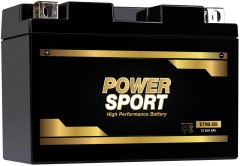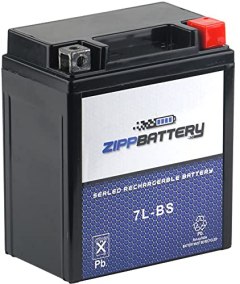BestReviews is reader-supported and may earn an affiliate commission. Details

A maintenance-free motorcycle battery that is sure to serve you well for years to come.
12V maintenance-free battery. Holds a charge three times longer than traditional motorcycle batteries. Sealed and spill-proof. No need to ever add water to the battery.
Battery fit sometimes is very tight.

A high-performance motorcycle battery that is ready out of the box.
Arrives fully charged. Maintenance-free. Spill-proof with no water checks required. Economical pricing makes the battery a great option for street-cruisers, ATVs, street-touring motorcycles, and street motor scooters.
Inferior cranking amps in contrast to comparable motorcycle batteries.

A motorcycle battery that lasts 1,000 charges or more.
12V fully charged battery. Chrome case ensures the motorcycle battery is resistant to shocks, vibrations, and heat. Design prevents leaks and corrosion. Includes heavy-duty terminals designed to withstand wear, pressure, and torquing.
Terminals may be too large for some motorcycle connectors.

A top-notch motorcycle battery constructed with lead calcium alloy and absorbed glass mat technology.
Can be mounted in any arrangement for added convenience. Design prevents leaks and corrosion. Fiberglass mat separators and high cell compression help extend the motorcycle battery's lifespan.
Terminals won't line up properly with many popular motorcycles.

A first-rate battery for motorcycles and ATVs.
Boasts a 70% longer cycle life compared to conventional deep cycle motorcycle batteries. Full recharge requires 4 to 6 hours. Vibration resistant. Proven to perform in extreme temperatures.
More expensive than similar motorcycle batteries.

We recommend these products based on an intensive research process that's designed to cut through the noise and find the top products in this space. Guided by experts, we spend hours looking into the factors that matter, to bring you these selections.

Modern motorcycles, with often complex engine management systems, put considerable demand on their batteries. Gone are the days when you could just kick-start the beast or when any old 6-volt box would do.
Battery manufacturers have responded by not just by increasing output but also offering different types of batteries. But if you don’t know your wet-cell from your lithium-ion, it can all get a bit confusing. One 12-volt motorcycle battery might look a lot like another, but there are big differences inside.
After exhaustive technical and practical research, we’re able to recommend the models we think stand out. They offer performance and value solutions for just about every motorcycle. The following motorcycle battery shopping guide provides additional technical information and answers to a number of common questions.

The outer boxes might look the same because they all have to fit within a given space on your motorcycle, but the chemistry inside can differ. The four options are flooded wet-cell lead-acid, absorbed glass mat (AGM), gel, and lithium-ion (Li-ion).
Wet-cell battery
The standard wet-cell vehicle battery has been around for over 150 years. It is a combination of lead plates, sulfuric acid, and distilled water that remains a reasonably efficient way of storing a charge, although it needs regular checks to maintain fluid levels. These batteries are cheap, but the big disadvantage for the motorcyclist is that if you tip one over, you get acid everywhere.
AGM battery
The AGM motorcycle battery is a natural development from the standard lead-acid battery, which uses dry-cell technology. It is sealed and so maintenance-free. The other big benefit for motorcyclists is that with nothing to spill out, the battery doesn’t have to stay upright. Without the liquid between the plates, it can be made thinner, so it requires less space. With no real negatives, this has become the most common type of motorcycle battery by far.
Gel battery
Gel motorcycle batteries are filled with a jelly-like combination of sulfuric acid and silica. These share all the benefits of AGM batteries, are largely unaffected by temperature fluctuations, and are highly resistant to vibration, all of which makes one ideal as a motorcycle battery.
Gel batteries have two disadvantages. First, they can only take charge slowly. You can jump-start them OK, but you can’t rapid-charge them. Second, they’re more expensive than AGM batteries. It isn’t a vast difference, but it’s enough to restrict their popularity.
Li-ion battery
Lithium-ion motorcycle batteries are the most recent development. They are solid-state, like a camera or phone battery, and so maintenance-free, plus they typically last three to five times longer than an AGM equivalent. Li-ion batteries can be made much smaller and as much as 70% lighter, and they’re completely safe. If you smash one to pieces, all you have is a smashed battery.
On the downside, Li-ion batteries are costly and sluggish in cold weather, and they don’t handle lots of accessories well.
In a nutshell, if you’ve got a lightweight sports bike and you’re trying to save every pound, lithium-ion motorcycle batteries are great. If you’ve got a fully loaded touring bike, stick with AGM.
Just about all motorcycle batteries are 12 volts, but there are notable performance differences that set them apart, and these differences have a big impact on cost.
CCA and Ah
Your owner’s manual and your existing motorcycle battery should give you two pieces of vital information: the cold cranking amps (CCA) and ampere hours (Ah).
CCA: Technically, the CCA is the number of amps your battery supplies at 7.2 volts for 30 seconds when the ambient temperature is 32°F. In real terms, it’s that initial burst of power required to start your motorcycle. The number provided by the bike’s manufacturer is a minimum. There’s no harm in buying something with a higher rating, and doing so is usually advised if you start adding electrical or electronic accessories.
Ah: An ampere-hour rating is the equivalent of one amp of charge being supplied for one hour. So an eight ampere hour battery provides eight amps for one hour or one amp for eight hours. In practical terms, if you compare two batteries with the same CCA, the one with the higher ampere hours will
deliver the same output for longer. It’s not a big deal when you’re starting your bike, but it is if you’re running extra lights, gadgets, or heated clothing.
When changing your motorcycle battery, you always need to at least match the recommended minimum of both CCA and Ah. More isn’t necessary, but it can be beneficial depending on the setup of your bike.
Size
Finally, it’s really important to check size, something that’s often overlooked. The battery box on a big V-twin cruiser is likely a very different size than that on an Italian hypersports bike!

There are always deals on cheap motorcycle batteries that seem to offer remarkable value, but check the specification carefully. Often the performance is inadequate and life expectancy short. The key here, as we explain above, is not the voltage but cold cranking amps and ampere hours. It’s absolutely vital you get what your motorcycle demands. Trying to short-cut it to save a few bucks is a waste of money.
Inexpensive: Good-quality budget batteries for motorcycles with modest power demand start at around $30. Prices rise more or less in line with the output provided, though big-name brands might attract a small premium.
Mid-range: High-performance sealed lead-acid motorcycle batteries cost around $75 to $120, depending on the specification.
Expensive: At the top end of the scale, powerful long-lasting versions can be as much as $150.

Q. Why is my battery going flat even when I ride my motorcycle regularly?
A. You probably know that an unused battery loses a small amount of charge every day, but even if you ride regularly, it might not be enough to keep it in optimum condition. Short rides – a few miles or under ten minutes – probably don’t generate enough charge to replace the energy used. If your battery is already old, the effect is exaggerated.
You can usually fix the problem by leaving your battery on charge overnight. Alternatively, go for a half-hour ride at least once a week – a much more fun way of doing it!
Q. Should I take the battery off the bike if I can’t ride through winter?
A. You can normally leave it on the bike and charge it in situ once every month or six weeks to keep it in peak condition. That way, it’s always ready to go if you do get the chance for a ride. If you live in a place where that’s just not going to happen, you can remove the battery, but check whether the bike’s manufacturer recommends it. The complex computers on some modern motorcycles shouldn’t be turned completely off. Either way, if you have a modern smart battery charger, you can leave it on a trickle charge (with no fear of it damaging the battery) until the weather improves.
Q. Can I throw my old motorcycle battery in the trash?
A. Please don’t. It could contain harmful chemicals and materials, and in most cases the entire thing can be successfully recycled. Your local motorcycle or auto supply store will probably take it off you, or your local recycling center.
Get emails you’ll love.
Learn about the products you’re wondering if you should buy and get advice on using your latest purchases.
